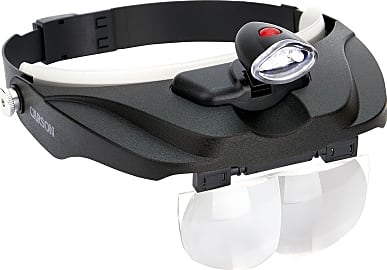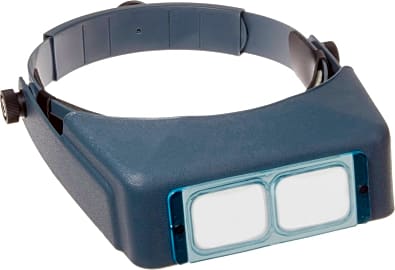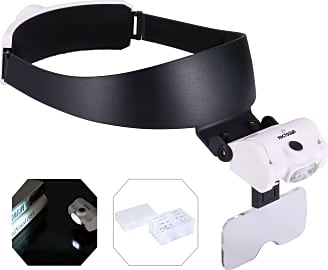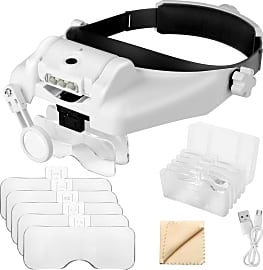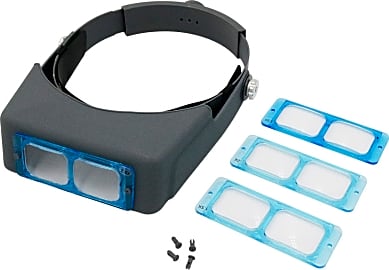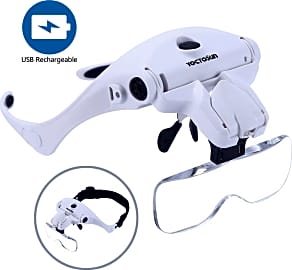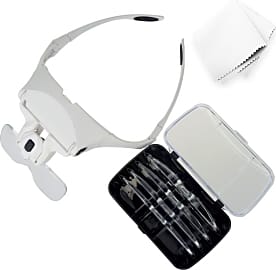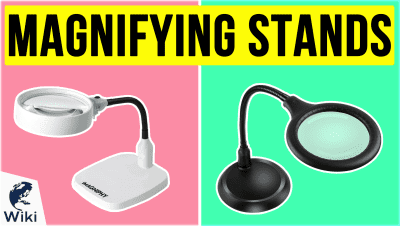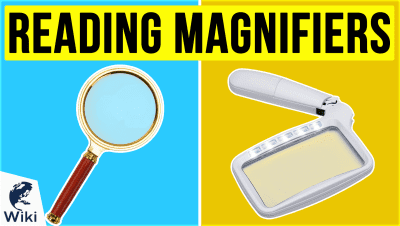The 10 Best Headband Magnifiers

This wiki has been updated 39 times since it was first published in May of 2016. Perfect for hobbyists, arts and crafts enthusiasts, watch and jewelry repairers, and anyone who works on today's tiny electronic devices, these headband magnifiers let you see what you are working on clearly while leaving your hands free to get on with the job. Our picks are sturdy and lightweight, and most have built-in headlamps, making them suitable for day or night. When users buy our independently chosen editorial selections, we may earn commissions to help fund the Wiki.
Editor's Notes
November 09, 2020:
For this update, we removed the Morduedde Hands Free due to availability concerns, as well as the Housweety LED because of complaints about their longevity and overall comfort.
We added another glass lens option, the Donegan DA-4. This is a higher-priced model, but one whose reputation for quality could be worth it to some users. It’s similar to the Donegan DA-S1 Complete Kit we have on our list, but without the included case and kit. If you’re looking for a high-quality unit that will last a while, this is a great choice.
We also added the Sunjoyco Professional, a unit that includes an impressive amount of lenses and accessories, as well as a rechargeable LED light. All these lens options provide you with the ability to create 23 levels of magnification, which sounds great, but might be a bit overkill for the casual user.
Magnifiers that use glass lenses, like the MagnifyLabs Optical Visor, and the Donegan DA-4, are advisable for professionals or serious hobbyists. Acrylic lenses are fine for occasional use, but they are easy to scratch, and if used for extended periods of time can lead to serious eye strain and headaches.
If you don't have enough work to justify a head-worn magnifyer, you might be better off with one of these magnifying stands. Or, if you're just looking for something to use occasionally, a good old fashioned reading magnifier might be a better choice.
December 22, 2019:
As a rule of thumb, glass lenses are generally better than acrylic as they afford more clarity, though this isn’t always the case (it depends on the quality of acrylic used and on manufacturing). The best glass-lens models offer better magnification clarity than the best acrylic lenses, and this is why the MagnifyLabs Optical Visor and Donegan OptiVISOR are some of your best options here – both use glass lenses that provide a lot of clarity. You’ll notice the difference between high-quality lenses (especially high-quality glass lenses) and lower-quality lenses while performing finer craftwork and electronic work or jewelry appraisals – not to mention the level of eye-strain you experience after working for a couple of hours. Both the newly added MagniPros Optical and Carson Optical Pro Series MagniVisor are notable exceptions that have some very good acrylic lenses.
The Donegan DA-S1 Complete Kit is essentially a kit-version of the Donegan OptiVISOR and I thought it redundant to introduce the same model twice in one listing. While the Donegan OptiVISOR is certainly one of the better products on the market in terms of the clarity and quality of magnification lenses used, unlike with other visor options, which typically come with a headlamp and a set of lenses, the basic OptiVISOR model is sold as a barebones package, with an option to add on lenses, and so in light of that lack of practicality, I removed the standalone option. The kit is a bit of an investment, but it comes with everything you need for the high-quality OptiVISOR (plus the case is quite handy for safely carrying around and taking care of an expensive model and fragile lenses).
I was initially tempted to add the GXG-1987, but its very similar to the Donegan – they’re both great models and both have glass lenses – in the end, I chose to prioritize variety here because so many models in this category can be similar in look and function; so, as a last minute decision, I decided to leave it out and include another good, but slightly more unique pick, for variety – the Yoctosun EGM. I also updated the Yoctosun Head Mount to a newer version which features a USB port for recharging its headlamp.
Two Crucial Concepts: Magnification and Focal Length
Focal length tells you how far away an object should be from the lens for optimal focus.
When you’re buying a headband magnifier, two prominent pieces of information you’ll see are magnification and focal length. The former refers to the strength of a lens, while the latter tells you at what distance you can view items. To get the most comfortable experience, you’ll want to not only pay attention to these numbers, but also consider what you’re working on and how you work. This means avoiding the tendency to assume that a bigger magnification is always better, a common error. To give you a better idea about how to choose, we’ll break down magnification and focal length separately.
Magnification refers to how much bigger the lens will make an item appear. If a lens has a magnification of 1.5x, that means it’ll cause the item to look 1 1/2 times as large; a magnification of 2x will make the item twice as large, and so on. You’ll also see the term diopter used from time to time. Lenses with a higher diopter will also have a higher magnification. You can calculate the power (i.e., magnification) of a lens if you know the diopter: the diopter divided by 4 plus 1 equals power. So, a lens with a diopter of 12 would have a magnification power of 4x (12/4 + 1).
Focal length tells you how far away an object should be from the lens for optimal focus. If a lens has a focal length of 20 inches, you’ll need the object you’re looking at to be 20 inches away from the lens for it to be in focus. Focal length and magnification are inversely correlated, meaning that as one gets bigger, the other gets smaller. For example, one of the most popular headband magnifiers comes with lenses that range from a 20-inch focal length lens with 1.5x magnification to a 4-inch focal length lens with 3.5x magnification.
As mentioned, a common error people make is to assume they need the most powerful magnification they can get. But if you’re painting model cars, will you really be holding them 4 inches from your headband magnifier? Or if you’re knitting or working crossword puzzles, will you want to hold these items so close to your face? Or would it be more comfortable to hold them in your lap? Thinking about what you do and how you do it will ensure that you choose a product with the most comfortable focal length and magnification power.
Other Important Features
Luckily, many headband magnifiers come with several lenses, or allow you to purchase additional lenses as your needs change, which makes these products versatile. Perhaps one day you’re painting tiny artwork on pennies and the next you’re reading a book; a visor with a range of lenses will let you tackle each task in comfort. But interchangeable lenses aren’t the only feature you should seek. Headband magnifiers are available with a wide range of features that will make various tasks much easier.
There are even headband magnifiers that let you wear safety goggles at the same time.
To begin with, most headband magnifiers offer extras that make wearing them more comfortable. Most, if not all, are adjustable, and the majority have some type of padding to keep your forehead from feeling pinched. Some even let you switch between wearing them like a headband and wearing them as a pair of glasses, thanks to a removable headband strap.
Next, some headband magnifiers let you flip the lens portion up so that you don’t have to keep putting the headband on and taking it off as you switch between normal and magnified work. These also commonly let you adjust the angle of the lenses.
Then, you’ll find headband magnifiers that feature a bright light to help illuminate the item you’re magnifying. These are especially useful for hobbyists who work with small details. Many lights are fixed in place, but a few models offer lights that are moveable.
Last, but certainly not least, is how well the headband works with your own prescription glasses. Some headband magnifiers are designed so that the wearer can keep his or her own glasses on, while others have a tighter fit and don’t offer enough room. There are even headband magnifiers that let you wear safety goggles at the same time.
A Historical Perspective
With all of these great features, it’s pretty obvious just how many uses a headband magnifier has: electronic work, jewelry repair, painting, needle crafts, and just plain old reading. But imagine that archaeologists 3,000 years from now dug up one of these items. Would they immediately understand why it was so useful and how people actually used it? Or might they speculate on the range of uses of such an item?
This is a problem that archaeologists have faced before with optical devices, perhaps most notably with the Nimrud Lens.
This is a problem that archaeologists have faced before with optical devices, perhaps most notably with the Nimrud Lens. This piece dates back to around 750 B.C.E. and is also called the Layard lens after its discoverer, the English anthropologist Sir Austen Layard. He found the item in what is now Iraq and immediately identified the piece as a lens. Examination of the piece confirmed that it could, indeed, have been used for magnifying; it has a focal length of about 4 inches and provides 3x magnification. This is equivalent to the lenses of many headband magnifiers available today.
Many optical experts and scientists oppose the idea that the Nimrud lens is a magnifying device, however, since there is no other evidence to support the idea that the Assyrians who fashioned it knew about or used these devices. Some experts have suggested that the lens could have been used for starting fires, and a few have suggested that it was part of an astronomical device. If the latter were true, then this device would predate what is accepted to be the first telescope, Hans Lippershey's model from the early 1600s.
Although these are exciting hypotheses, the truth is probably much more pedestrian. According to the British Museum, the piece is most likely a decorative inlay from a piece of furniture. No future scientists will mistake a headband magnifier for a piece of a chair or sofa, especially since we now leave overly ample written records, but who knows? Your humble headband magnifier could end up in a museum someday.


